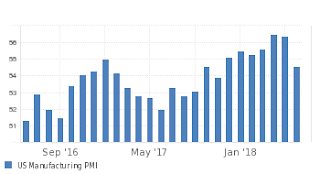Popular Economics Weekly
The sad reality is that in initiating trade wars with allies and opponents alike, President Trump could be bringing on the next Great Recession. Because breaking up trade alliances with our allies means less leverage in any negotiations with, say, China. For instance, our (former?) allies can now sell their products to the remaining 11 Asian members of the Trans-Pacific Partnership (TPP) that the US abandoned immediately after Trump took office, or China can sell to them rather than US.
The European Union would also be free to sell its products to others rather than suffer the tariffs Trump is levying on them. And Canada will also purchase more from them, replacing many of the products formally bought from US companies.
Nobel economist Paul Krugman is considered one of the most knowledgeable about foreign trade. He won the Nobel Prize for formulating just why countries and regions trade with each other, and trade protectionism died out after WWII.
It’s called the theory of comparative advantage, because more benefit if those that produce things most efficiently (the cheapest) get to export them to countries that can’t produce them so cheaply, and the modern trading system was formed.
China manufacturers are capturing more of the solar panel market because it can make them cheaply. Canada’s lumber prices are cheaper, so it exports lumber to the U.S. The National Association of Realtors reports that tariffs on Canadian lumber imports is already raising the cost of construction on an average-priced American home $9,000 at a time when fewer Americans can afford a home.
“The U.S. currently exports about 12 percent of GDP, says Professor Krugman. “Not all of that is domestic value added, because some components are imported. But there’s still a lot of the economy, maybe 9 or 10 percent, engaged in production for foreign markets. And if we have the kind of trade war I’ve been envisaging, something like 70 percent of that part of the economy – say, 9 or 10 million workers – will have to start doing something else. And there would be a multiplier effect on many communities now built around export industries, which would lose service jobs too.”
Krugman also believes if this becomes a prolonged trade war, “we’re talking about a really big rollback of world trade. Figure 1 shows world trade (exports plus imports) as a share of world GDP back to 1950; a 70 percent reduction would bring us roughly back to 1950s levels. If Trump is really taking us into a trade war, the global economy is going to get a lot less global.”Does anyone realize what 1950 levels of trade would mean in today’s world? That’s before the baby boomers became consumers with the huge increase in demand for consumer goods. Modern day consumers would now be competing for less than half the number of imported products, which means soaring prices, which leads to higher inflation and interest rates, which are the sign of an overheating economy.
And this is happening just when Trump’s avowed goal is to bring back more manufacturing jobs that mostly depend on exports to other countries. It’s a solvable conundrum. The loss of manufacturing jobs because of foreign tariffs on US goods could cancel out whatever benefits protectionism would garner for American steelworkers, or auto manufacturers.
And where will the trade war hurt first? Tariffs on exports like Kentucky Bourbon, Wisconsin dairy products, Iowa pork, and soybeans were the first to be raised by the EU and China, because they come from Trump territory.
It’s much better to work with our allies than attempt to bully them.
Harlan Green © 2018
Follow Harlan Green on Twitter: https://twitter.com/HarlanGreen











